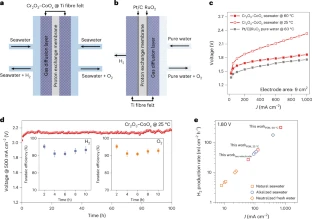Science Daily February 1, 2023
The use of vast amounts of high-purity water for hydrogen production may aggravate the shortage of freshwater resources. Seawater is abundant but must be desalinated before use in typical proton exchange membrane (PEM) electrolysers. An international team of researchers (China, Australia, USA – Kent State University) has demonstrated direct electrolysis of real seawater that has not been alkalised nor acidified, achieving long-term stability exceeding 100 h at 500 mA cm−2 and similar performance to a typical PEM electrolyser operating in high-purity water. This was done by introducing a Lewis acid layer (for example, Cr2O3) on transition metal oxide catalysts to dynamically split water molecules and capture hydroxyl anions. Such in situ generated local alkalinity facilitates the kinetics of both electrode reactions and avoids chloride attack and precipitate formation on the electrodes. A flow-type natural seawater electrolyser with Lewis acid-modified electrodes (Cr2O3–CoOx) exhibits the industrially required current density of 1.0 A cm−2 at 1.87 V and 60 °C… read more. TECHNICAL ARTICLE

Performance of flow-type natural seawater electrolyser. Credit: Nature Energy (2023)